Scotland's People Annual report: Results from 2009/2010 Scottish Household Survey
A National Statistics publication for Scotland, providing reliable and up-to-date information on the composition, characteristics, behaviour and attitudes of Scottish households and adults
13 Culture and Sport
Introduction and Context
The Scottish Government is committed to promoting and supporting sport and cultural activities because it recognises and values the benefits that sport and culture bring, not only to individuals, but to our communities. The Government's work is focused on widening access and participation and ensuring that the necessary infrastructure is in place to deliver sporting and cultural opportunities whilst promoting a drive to achieve sporting and cultural excellence. This work contributes to the Government's strategic objectives including:
- (Smarter) Expanding opportunities for people in Scotland to succeed from nurture through to life long learning, ensuring higher and more widely shared achievements;
- (Healthier) Helping people to sustain and improve their health, especially in disadvantaged communities, ensuring better, local and faster access to health care;
- (Safer and Stronger) Helping local communities to flourish, becoming stronger, safer places to live, offering improved opportunities and a better quality of life;
The Scottish Household Survey is the primary source of information on cultural attendance and participation and sporting participation in Scotland and it is the only source of data on attendance and participation at local authority level. Questions on cultural attendance and participation and sporting participation were introduced in the Scottish Household Survey for the first time in 2007. It is possible to obtain local authority level data once every two years.
The suite of culture and sport questions within the Scottish Household Survey covers attendance at cultural events and places, and participating in cultural and sports activities. This chapter explores the prevalence and frequency of attending cultural events and places of culture and participating in cultural activities in the last 12 months and of participation in sport in the last 4 weeks.
Scottish Household Survey data on culture and sport can be used for a number of different purposes. The data can be used to understand and monitor levels of cultural engagement and sporting participation both at the national and sub-national levels and to inform decisions on government and local government policy making. It can also be used to facilitate academic research.
Main Findings: cultural attendance and participation
Within this report, attendance at "a cultural event or place of culture" is defined as those people who attend at least one type of cultural place in the previous year. There are a number of different types of cultural events and places of culture. Examples of these include cinemas, libraries and live music events. For a complete list of cultural places or events see the Glossary in Annex 2.
Likewise, participation in any cultural activity means that people take part in at least one activity in the previous year. Examples of cultural activities include reading for pleasure, dancing and crafts. The Glossary in Annex 2 provides complete list of activities which are classed as cultural participation.
Around three quarters of adults (74%) attended a cultural event or place of culture in the last 12 months. This estimate is broadly in line with overall cultural attendance for 2007/08 (75%). The most popular form of cultural attendance is watching films at a cinema (52% of adults interviewed). The next most popular cultural places are libraries (with 28% of respondents saying they had visited in the previous year), live music events (27%), plays or theatrical performances (26%) and museums (26%).
Attendance is higher amongst women than men at most types of cultural place or event. The overall levels of cultural attendance falls with increasing age of respondent. This is partly due to the popularity of cinema attendance amongst younger age groups. Attendance is highest amongst those who have stated that they have degrees or professional qualifications and lowest amongst those with no qualifications. For specific places or events, attendance is often highest for respondents who live in large urban areas. This is particularly notable for cinema attendance, visiting galleries and museums and street arts.
In 2009/2010, 71% of adults participated in a cultural activity in the previous 12 months. This is consistent with overall cultural participation for 2007/08 (72%). By far the most popular form of cultural participation is reading for pleasure (62% of respondents), with dancing being the next most popular activity (18%).
Participation in most cultural activities is higher amongst women than men. Participation in some but not all cultural activities decreases with increasing age of respondent. Participation in reading for pleasure shows little difference with age, although it is a slightly less popular activity amongst 16 to 24 year olds. As with cultural attendance, participation in cultural activities is highest amongst people with degrees or professional qualifications and lowest amongst those with no qualifications. The levels of cultural participation in urban and rural areas are different for specific cultural activities.
This report provides high level information on cultural attendance and participation only. More detailed information on the reasons for and against attending cultural places and participating in particular activities is available in the Scottish Household Survey People and Culture in Scotland 2007/08 report, published in November 2009 [76].
Attendance at Cultural Events and Places
Attendance at specific cultural events or places
Figure 13.1 shows levels of attendance by adults at specific cultural events and visiting places of culture (not as a result of paid work, school or academic activities) in the last 12 months for 2009/2010. It can be inferred from the chart that around three quarters of adults (74%) attended a cultural event or place of culture in the last 12 months.
The chart shows that:
- Just over half of respondents (52%) viewed a film at a cinema in the last 12 months, making this the most common type of cultural attendance.
- The next most common types of cultural attendance are libraries (28%), live music events (27%), plays or other theatrical performances (26%) and museums (26%).
- Attendance at three other types of cultural place is between 15 and 20 per cent. These are historical or archaeological places (19%), exhibitions (including art) and galleries (both 17%).
- Attendance at other cultural events or places of culture is lower (at around 10 per cent or lower of respondents).
- Just over a quarter of adults (26%) did not attend a cultural event or place of culture in the last 12 months.
In 2007/2008, 75% of adults attended any cultural event or visited a place of culture in the previous year - roughly the same as in 2009/2010. Levels of attendance at specific cultural events or places of culture in 2009/2010 are in line with those reported in 2007/2008 Scottish Household Survey, apart from library attendance which fell from 31% to 28%.
Figure 13.1: Attendance at cultural events and visiting places of culture in the last 12 months
2009/2010 data, Adults (base: 18,756)
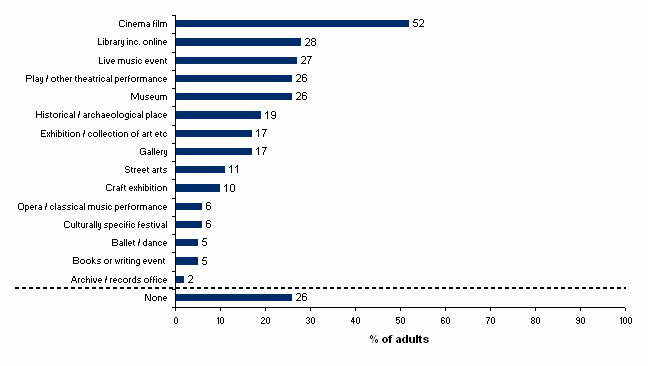
Attendance by gender and age
Table 13.1 shows levels of attendance at any cultural event or place of culture in the last 12 months by gender and age of respondent for 2009/2010.
Table 13.1: Attendance at cultural events and visiting places of culture in last 12 months by gender and age
Column percentages, 2009/2010 data
| Adults | Male | Female | 16 to 24 | 25 to 34 | 35 to 44 | 45 to 59 | 60 to 74 | 75 plus | All |
|---|---|---|---|---|---|---|---|---|---|
| No | 28 | 25 | 13 | 15 | 19 | 28 | 35 | 54 | 26 |
| Yes | 72 | 75 | 87 | 85 | 81 | 72 | 65 | 46 | 74 |
| Total | 100 | 100 | 100 | 100 | 100 | 100 | 100 | 100 | 100 |
| Base | 8,284 | 10,472 | 1,554 | 2,515 | 3,149 | 4,529 | 4,566 | 2,443 | 18,756 |
- Around three quarters (74%) of adults attend a cultural event or place of culture
- More women attend a cultural event than men (75% and 72% respectively) although the difference between men and women is less than that for cultural participation. Analysis on cultural participation by gender is presented later in this chapter.
- The level of cultural attendance declines with age and decreases considerably for those aged 45 or older. Whilst levels of cultural attendance are over 80% for adults aged 16 to 45, the figure falls to 65% for those aged 60 to 74 and to less than half (46%) of all adults aged 75 or over.
Table 13.2 shows how attendance at specific cultural events and visiting places of culture varies by gender and age.
Table 13.2: Attendance at cultural events and visiting places of culture in the last 12 months by gender and age
Percentages, 2009/2010 data
| Adults | Male | Female | 16 to 24 | 25 to 34 | 35 to 44 | 45 to 59 | 60 to 74 | 75 plus | All |
|---|---|---|---|---|---|---|---|---|---|
| Film at cinema or other venue | 51 | 53 | 79 | 72 | 63 | 48 | 29 | 11 | 52 |
| Library (any type of library, e.g. public/mobile/online) |
25 | 32 | 31 | 31 | 33 | 25 | 28 | 22 | 28 |
| Other live music event e.g. jazz event |
29 | 26 | 39 | 36 | 31 | 27 | 17 | 6 | 27 |
| Play, drama other theatrical performance (musical/pantomime) |
21 | 32 | 19 | 26 | 29 | 31 | 28 | 17 | 26 |
| Museum | 26 | 27 | 20 | 32 | 33 | 27 | 25 | 13 | 26 |
| Place of historical or archaeological interest |
21 | 17 | 12 | 20 | 24 | 22 | 19 | 8 | 19 |
| Exhibition or collection of art, photography or sculpture |
17 | 17 | 13 | 20 | 19 | 20 | 17 | 9 | 17 |
| Gallery | 16 | 17 | 13 | 19 | 19 | 19 | 17 | 9 | 17 |
| Street arts (art in everyday surroundings like parks, streets or shopping centre) or circus (not animals) |
10 | 11 | 10 | 15 | 14 | 12 | 6 | 3 | 11 |
| Craft exhibition | 8 | 12 | 4 | 9 | 11 | 14 | 13 | 6 | 10 |
| Opera/operetta/classical music performance |
5 | 7 | 4 | 5 | 5 | 7 | 10 | 6 | 6 |
| Culturally specific festival (mela/feis) |
7 | 6 | 6 | 9 | 8 | 7 | 5 | 2 | 6 |
| Ballet/contemporary dance/other live dance event e.g. multi cultural |
3 | 7 | 4 | 6 | 6 | 5 | 5 | 2 | 5 |
| Event connected with books or writing |
5 | 6 | 4 | 6 | 6 | 6 | 5 | 2 | 5 |
| Archive or records office | 3 | 2 | 2 | 2 | 2 | 3 | 3 | 1 | 2 |
| None | 28 | 25 | 13 | 15 | 19 | 28 | 35 | 54 | 26 |
| Base | 8,284 | 10,472 | 1,554 | 2,515 | 3,149 | 4,529 | 4,566 | 2,443 | 18,756 |
Columns add to more than 100% since multiple responses allowed.
This question is only asked of three quarters of the sample.
The key points are:
- Women are more likely to attend most cultural events than men. The greatest percentage point difference is for attendance at plays, drama or theatrical performances (32% of women compared with 21% of men). Library visits also show considerable differences by gender, with 32% of women and 25% of men reporting that they have visited in the last 12 months.
- There are some cultural events where attendance by men is greater than for women. For instance, 29% of men state that they have attended a live music event in the last year compared with 26% of women.
- Cultural attendance at specific events vary by age for particular activities. However, overall attendance at any cultural event is highest for the younger age groups and lowest for the oldest age groups.
- Differences between the youngest and oldest age groups are most marked for cinema attendance and for attendance at live music events. Almost four fifths (79%) of 16 to 24 year olds state that they have viewed films at the cinema in the last 12 months, compared with 11% of those aged 75 or greater. Almost four out of ten (39%) of 16 to 24 year olds state that they have attended a live music event in the last 12 months. This compares with 17% of 60 to 74 year olds and 6% of those aged 75 or greater.
- For some cultural places, attendance is highest for the middle age groups. This includes attendance at plays, drama or theatrical performances with 31% of 45 to 59 year olds stating they attended, compared with 19% of 16 to 24 year olds.
- Attendance at some cultural places show a more uniform pattern across different age groups. This includes visits to libraries, in which attendance figures were slightly lower for those aged 45 or greater.
Attendance by highest level of qualification
Figure 13.2 shows that in 2009/2010, attendance at cultural places and visiting places of culture is highest for those with degrees or professional qualifications (91%). Attendance is lowest for those with no qualifications (47%) and those where qualifications are not known (42%).
Figure 13.2: Attendance at cultural events and visiting places of culture in the last 12 months by highest level of qualification
2009/2010 data, Adults (base: 18,756)
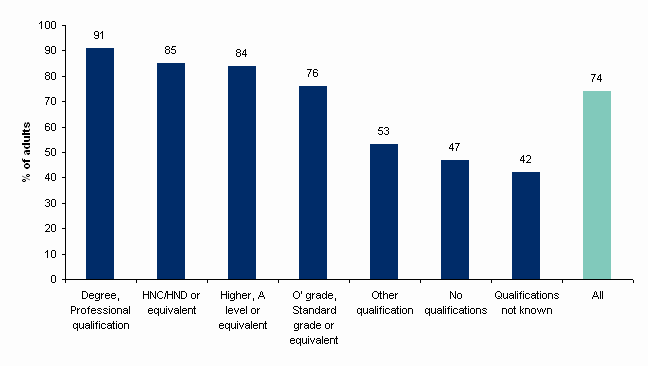
Table 13.3 shows that in 2009/2010, attendance at all specific cultural events is highest for adults with a degree or professional qualification. Attendance at all types of cultural event or place is lowest among adults with no qualifications.
Table 13.3: Attendance at cultural events and visiting places of culture in the last 12 months by highest qualification level
Percentages, 2009/2010 data
| Adults | Degree, Professi- onal qualific- ation |
HNC/ HND or equivalent | Higher, A level or equivalent | O'Grade, Standard grade or equivalent | Other qualific- ation |
No qualific- ations |
Qualific- ations not known |
All |
|---|---|---|---|---|---|---|---|---|
| Film at cinema or other venue | 68 | 64 | 66 | 57 | 25 | 22 | 22 | 52 |
| Library (any type of library, e.g. public/mobile/online) | 44 | 33 | 32 | 23 | 19 | 14 | 13 | 28 |
| Other live music event e.g. jazz event | 40 | 36 | 36 | 24 | 11 | 10 | 5 | 27 |
| Play, drama other theatrical performance (musical/pantomime) | 43 | 31 | 29 | 18 | 17 | 12 | 12 | 26 |
| Museum | 46 | 29 | 29 | 18 | 14 | 11 | 11 | 26 |
| Place of historical or archaeological interest | 37 | 22 | 20 | 11 | 8 | 5 | 5 | 19 |
| Exhibition or collection of art, photography or sculpture | 36 | 18 | 18 | 8 | 8 | 4 | 3 | 17 |
| Gallery | 34 | 16 | 19 | 8 | 7 | 5 | 4 | 17 |
| Street arts (art in everyday surroundings like parks, streets or shopping centre) or circus (not animals) | 19 | 14 | 12 | 8 | 3 | 3 | 2 | 11 |
| Craft exhibition | 20 | 12 | 11 | 6 | 5 | 4 | 3 | 10 |
| Opera/operetta/classical music performance | 14 | 6 | 5 | 3 | 4 | 2 | 1 | 6 |
| Culturally specific festival (mela/feis) | 14 | 8 | 6 | 4 | 2 | 2 | 2 | 6 |
| Ballet/contemporary dance/other live dance event e.g. multi cultural | 11 | 6 | 4 | 3 | 2 | 1 | 1 | 5 |
| Event connected with books or writing | 13 | 5 | 4 | 2 | 1 | 1 | - | 5 |
| Archive or records office | 5 | 4 | 2 | 1 | 1 | 0 | - | 2 |
| None | 9 | 15 | 16 | 24 | 47 | 53 | 58 | 26 |
| Base | 4,821 | 1,704 | 2,551 | 3,226 | 1,286 | 5,024 | 144 | 18,756 |
This question is only asked of three quarters of the sample
Attendance by area deprivation
Figure 13.3 shows that levels of cultural attendance varies with the area deprivation that respondents live in. Respondents living in more deprived areas are the least likely to attend a cultural place or event in 2009/2010. There is greater than a 20 percentage point difference in cultural attendance by adults between the most and least deprived areas (62% compared with 85%).
Figure 13.3: Attendance at cultural events and visiting places of culture in the last 12 months by Scottish Index of Multiple Deprivation
2009/2010 data, Adults (base: 18,756)
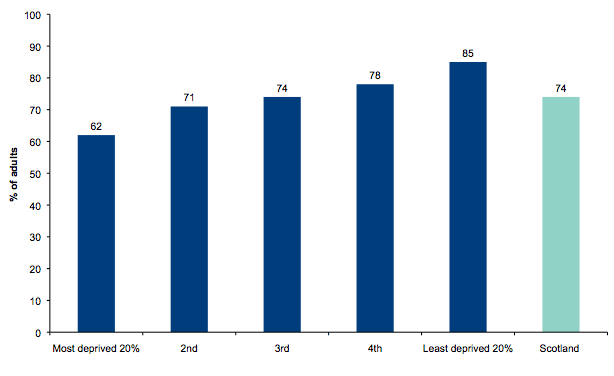
Attendance by long-standing illness, health problem or disability
Figure 13.4 shows that those with either a disability, illness or health problem, or both, are much less likely to attend a cultural event than those without.
Figure 13.4: Attendance at cultural events and visiting places of culture in the last 12 months by long-standing illness, health problem or disability
2009/2010 data, Adults (base: 18,756)
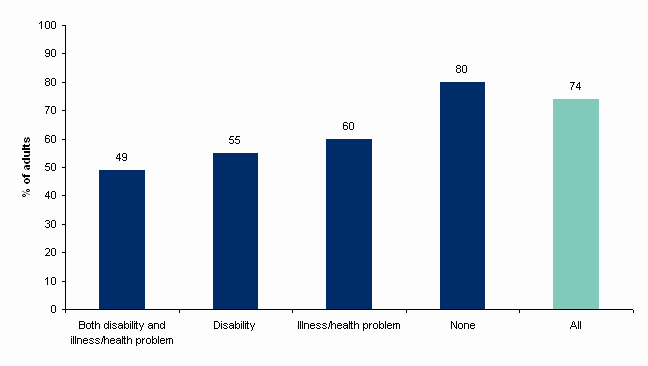
Attendance in urban and rural areas
Figure 13.5 shows that attendance at cultural events and visiting places of culture in 2009/2010 is highest in large urban areas (77%), compared with 74% for Scotland as a whole.
Figure 13.5: Attendance at cultural events and visiting places of culture in the last 12 months by Urban Rural Classification
2009/2010 data, Adults (base: 18,745)
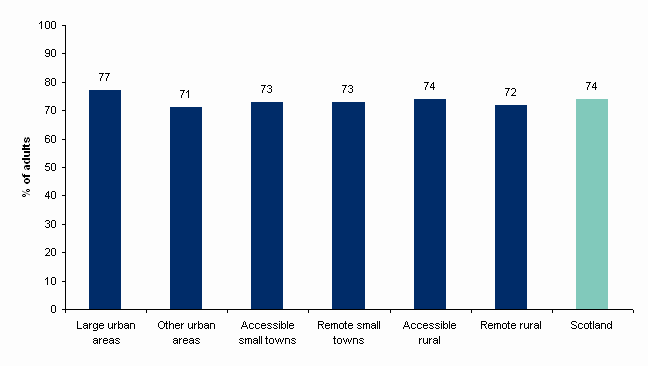
Table 13.4 shows that attendance at specific events or places of culture in 2009/2010 is often highest for respondents who live in large urban areas. This is particularly notable for cinema attendance, visiting galleries and museums and street arts. Attendance at places of historical or archaeological interest is highest amongst those who live in more rural areas.
Table 13.4: Attendance at cultural events and visiting places of culture in the last 12 months by Urban Rural Classification
Percentages, 2009/2010 data
| Adults | Large urban areas | Other urban areas | Accessible small towns | Remote small towns | Accessible rural | Remote rural | Scotland |
|---|---|---|---|---|---|---|---|
| Film at cinema or other venue | 58 | 49 | 50 | 43 | 49 | 41 | 52 |
| Library (any type of library, e.g. public/mobile/online) |
31 | 26 | 30 | 28 | 27 | 28 | 28 |
| Other live music event e.g. jazz event |
30 | 24 | 25 | 29 | 27 | 27 | 27 |
| Play, drama other theatrical performance (musical/pantomime) |
29 | 24 | 24 | 22 | 28 | 23 | 26 |
| Museum | 34 | 21 | 19 | 18 | 24 | 22 | 26 |
| Place of historical or archaeological interest |
20 | 16 | 17 | 16 | 24 | 24 | 19 |
| Exhibition or collection of art, photography or sculpture |
21 | 13 | 12 | 13 | 19 | 20 | 17 |
| Gallery | 22 | 12 | 13 | 9 | 17 | 16 | 17 |
| Street arts (art in everyday surroundings like parks, streets or shopping centre) or circus (not animals) |
14 | 9 | 7 | 8 | 9 | 8 | 11 |
| Craft exhibition | 9 | 8 | 11 | 13 | 15 | 18 | 10 |
| Opera/operetta/classical music performance |
7 | 5 | 5 | 4 | 7 | 7 | 6 |
| Culturally specific festival (mela/feis) |
8 | 4 | 4 | 7 | 6 | 9 | 6 |
| Ballet/contemporary dance/other live dance event e.g. multi cultural |
6 | 4 | 5 | 4 | 5 | 5 | 5 |
| Event connected with books or writing |
7 | 3 | 3 | 3 | 5 | 6 | 5 |
| Archive or records office | 3 | 2 | 1 | 3 | 3 | 3 | 2 |
| None | 23 | 29 | 27 | 27 | 26 | 28 | 26 |
| Base | 6,544 | 5,521 | 1,610 | 1,091 | 2,234 | 1,745 | 18,745 |
Columns add to more than 100% since multiple responses allowed.
This question is only asked of three quarters of the sample.
Frequency of attending cultural events or places
Table 13.5 provides more information on how regularly those who attended particular cultural events or visited places of culture had done so in the past year. The table shows that libraries are by far the most frequently visited cultural place or event. Of those that visited a library, over one in five (21%) visited a library at least once a week in the past year. A further 39% of respondents visited at least once a month. For comparison, of those who visited a cinema, 4% attended once a week and a quarter attended at least once a month. Visits to other cultural events or places in the past 12 months are far less frequent.
Table 13.5: Frequency of attending cultural events and visiting places of culture in the last 12 months
Row percentages, 2009/2010 data
| Adults | At least once a week | Less often than once a week / at least once a month | Less often than once a month / at least 3-4 times a year | Twice in the last 12 months | Once in the last 12 months | Don't know | Total | Base |
|---|---|---|---|---|---|---|---|---|
| Film at cinema or other venue | 4 | 25 | 43 | 19 | 9 | 0 | 100 | 8,611 |
| Library (any type of library, e.g. public/mobile/online) |
21 | 39 | 22 | 12 | 6 | 0 | 100 | 5,320 |
| Other live music event e.g. jazz event |
2 | 11 | 33 | 31 | 24 | 0 | 100 | 4,632 |
| Play, drama other theatrical performance (musical/pantomime) |
1 | 5 | 30 | 35 | 29 | 0 | 100 | 4,882 |
| Museum | 1 | 8 | 29 | 34 | 28 | 0 | 100 | 4,768 |
| Place of historical or archaeological interest |
1 | 9 | 34 | 31 | 25 | 0 | 100 | 3,426 |
| Exhibition or collection of art, photography or sculpture |
1 | 9 | 29 | 33 | 27 | 0 | 100 | 3,171 |
| Gallery | 2 | 9 | 29 | 33 | 26 | 0 | 100 | 3,014 |
| Street arts (art in everyday surroundings like parks, streets or shopping centre) or circus (not animals) |
2 | 6 | 17 | 30 | 45 | 0 | 100 | 1,783 |
| Craft exhibition | 1 | 5 | 22 | 34 | 37 | 0 | 100 | 2,103 |
| Opera/operetta/classical music performance |
1 | 5 | 24 | 26 | 42 | 1 | 100 | 1,209 |
| Culturally specific festival (mela/feis) |
1 | 3 | 15 | 30 | 51 | 0 | 100 | 1,234 |
| Ballet/contemporary dance/other live dance event e.g. multi cultural |
1 | 3 | 15 | 24 | 57 | 0 | 100 | 932 |
| Event connected with books or writing |
2 | 9 | 22 | 26 | 40 | 1 | 100 | 925 |
| Archive or records office | 5 | 8 | 20 | 28 | 39 | 1 | 100 | 454 |
This question is only asked of three quarters of the sample.
Participation in Cultural activities
Participation in specific cultural activities
Figure 13.6 shows levels of cultural participation in specific activities by adults in the last 12 months for 2009/2010. It can be inferred from the chart that 71% of adults participated in a cultural activity in the last year.
The chart shows that:
- Reading for pleasure is by far the most common cultural activity in 2009/2010 with 62% of adults saying that they have done this in the last year.
- The next most popular activity is dancing (18%), followed by crafts and playing and writing music (both 11%).
- Participation levels in all other cultural activities is less than 10%.
- Almost 30% of adults did not participate in any cultural activity in the past year (29%).
For comparison, in the SHS 2007/2008 Annual Report, 72% of adults participated in a cultural activity in the previous year, which is broadly in line with 2009/2010 results. In general, levels of participation in specific cultural activities in 2009/2010 are consistent with those reported in the SHS 2007/2008, but participation in dance is lower (22% in 2009/2010 compared with 18% in 2007/2008) and reading for pleasure fell by 2 percentage points to 62%.
Figure 13.6: Participation in cultural activities in the last 12 months
2009/2010 data, Adults (base: 18,757)
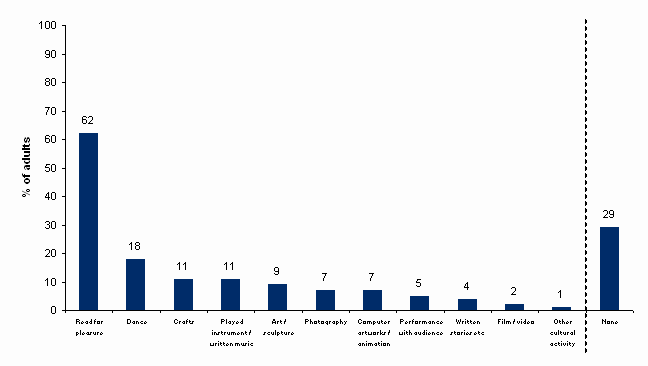
Participation by gender and age
Table 13.6 shows levels of participation in any cultural activity in the last 12 months by gender and age of respondent for 2009/2010.
Table 13.6: Participation in any cultural activity in the last 12 months by gender and age
Column percentages, 2009/2010 data
| Adults | Male | Female | 16 to 24 | 25 to 34 | 35 to 44 | 45 to 59 | 60 to 74 | 75 plus | All |
|---|---|---|---|---|---|---|---|---|---|
| Not participated in any | 35 | 23 | 31 | 27 | 27 | 28 | 27 | 36 | 29 |
| Participated in any | 65 | 77 | 69 | 73 | 73 | 72 | 73 | 64 | 71 |
| Total | 100 | 100 | 100 | 100 | 100 | 100 | 100 | 100 | 100 |
| Base | 8,284 | 10,473 | 1,554 | 2,516 | 3,149 | 4,529 | 4,566 | 2,443 | 18,757 |
It can be seen that:
- Just over 70% of adults participate in any cultural activity (71%)
- More women participate in a cultural activity than men (77% and 65% respectively).
- Levels of cultural participation are broadly constant for those aged 25 to 74 (at 72 to 73%) whilst participation levels are lower for 16 to 24 year olds (69%) and lower still for those aged 75 or over (64%).
Table 13.7 shows how participation in specific cultural activities varied by age and gender.
The key points are:
- Overall cultural participation is higher for women than men, but there are specific activities in which participation by men is greater.
- Women participate more than men in a number of cultural activities including reading for pleasure (69% compared with 55%), dancing (22% compared with 14%) and in crafts (16% compared with 6%).
- Participation in some activities is higher for men than women. This includes playing a musical instrument or writing music (14% of men, 8% of women), photography as an artistic activity (9% of men compared with 6% of women) and using a computer to create artworks or animation (8% of men compared with 5% of women).
- Participation in some but not all cultural activities decreases with increasing age of respondent. For instance, participation in dance is most popular for younger age groups (with a quarter of 16 to 24 year olds and 23% for 25 to 34 year-olds saying they danced), whilst the figure drops to 16% for 60 to 74 year olds and 6% for those aged 75 or above.
- Reading for pleasure shows little difference with age, although it is a slightly less popular activity amongst 16 to 24 year olds (52% compared with 62% for all adults across Scotland).
- Participation in crafts gradually increases by age from 7% of 16 to 24 year olds to 15% of 60 to 74 year olds.
Table 13.7: Participation in cultural activities in the last 12 months by gender and age
Percentages, 2009/2010 data
| Adults | Male | Female | 16 to 24 | 25 to 34 | 35 to 44 | 45 to 59 | 60 to 74 | 75 plus | All |
|---|---|---|---|---|---|---|---|---|---|
| Read for pleasure | 55 | 69 | 52 | 64 | 65 | 64 | 65 | 58 | 62 |
| Dance | 14 | 22 | 25 | 23 | 18 | 17 | 16 | 6 | 18 |
| Crafts such as textile, wood, pottery, etc. |
6 | 16 | 7 | 10 | 11 | 11 | 15 | 12 | 11 |
| Played a musical instrument or written music |
14 | 8 | 19 | 15 | 11 | 9 | 6 | 4 | 11 |
| Painting, drawing, printmaking or sculpture |
8 | 10 | 17 | 12 | 10 | 6 | 6 | 3 | 9 |
| Photography as an artistic activity (not family or holiday 'snaps') |
9 | 6 | 9 | 8 | 7 | 8 | 6 | 2 | 7 |
| Used a computer to create original artworks or animation | 8 | 5 | 11 | 10 | 7 | 5 | 4 | 1 | 7 |
| Rehearsed, performed or sang in front of audience, e.g. play or choir (not karaoke) |
5 | 4 | 9 | 5 | 4 | 4 | 3 | 1 | 5 |
| Written any stories, books, plays or poetry |
4 | 4 | 6 | 5 | 4 | 3 | 3 | 2 | 4 |
| Made films or videos as an artistic activity (not family or holidays) | 3 | 1 | 5 | 3 | 2 | 1 | 1 | 0 | 2 |
| Other cultural activity | 2 | 1 | 2 | 2 | 1 | 1 | 1 | 1 | 1 |
| None | 35 | 23 | 31 | 27 | 27 | 28 | 27 | 36 | 29 |
| Base | 8,284 | 10,473 | 1,554 | 2,516 | 3,149 | 4,529 | 4,566 | 2,443 | 18,757 |
Columns add to more than 100% since multiple responses allowed.
This question is only asked of three quarters of the sample.
Participation by highest level of qualification
Figure 13.7 shows that participation in any cultural activity in 2009/2010 is highest amongst adults with a degree or professional qualifications (87%) and lowest for those with no qualifications (54%).
Figure 13.7: Participation in any cultural activity in the last 12 months by highest level of qualification
2009/2010 data, Adults (base: 18,757)
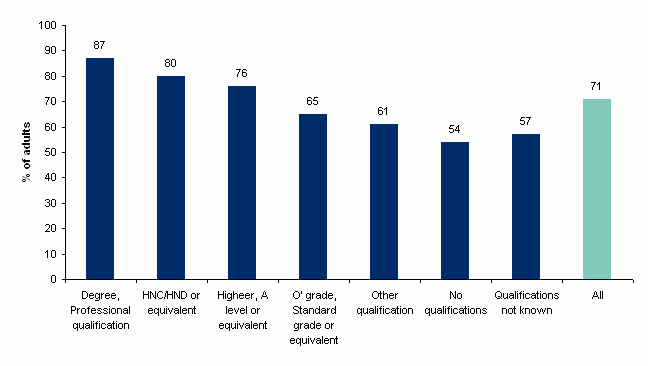
Table 13.8 shows that participation in specific cultural activities in 2009/2010 is consistently highest for those with a degree or professional qualification. Participation in specific activities is always lowest for those with no qualifications or where qualifications are not known.
Table 13.8: Participation in cultural activities in the last 12 months by highest level of qualification
Percentages, 2009/2010 data
| Adults | Degree, Professional qualification | HNC / HND or equivalent | Higher, A level or equivalent | O' Grade, Standard grade or equivalent | Other qualification | No qualifications | Qualifications not known | All |
|---|---|---|---|---|---|---|---|---|
| Read for pleasure | 82 | 69 | 65 | 52 | 52 | 45 | 46 | 62 |
| Dance | 24 | 23 | 21 | 17 | 12 | 10 | 13 | 18 |
| Crafts such as textile, wood, pottery, etc. | 16 | 14 | 12 | 8 | 9 | 7 | 10 | 11 |
| Played musical instrument/written music | 18 | 13 | 16 | 7 | 3 | 3 | 5 | 11 |
| Painting/drawing/printmaking/sculpture | 13 | 11 | 12 | 9 | 4 | 4 | 4 | 9 |
| Photography | 12 | 10 | 9 | 5 | 3 | 2 | 3 | 7 |
| Computer artworks or animation | 10 | 10 | 8 | 6 | 2 | 1 | 1 | 7 |
| Rehearsed/performed/sang | 8 | 5 | 7 | 3 | 1 | 1 | 3 | 5 |
| Written stories/books/plays/poetry | 7 | 4 | 5 | 3 | 2 | 1 | 1 | 4 |
| Made films/videos | 3 | 3 | 3 | 2 | 1 | 0 | - | 2 |
| Other cultural activity | 2 | 2 | 1 | 1 | 1 | 0 | 0 | 1 |
| None | 13 | 20 | 24 | 35 | 39 | 46 | 43 | 29 |
| Base | 4,821 | 1,704 | 2,552 | 3,226 | 1,286 | 5,024 | 144 | 18,757 |
Columns add to more than 100% since multiple responses allowed.
This question is only asked of three quarters of the sample.
Participation by area deprivation
Figure 13.8 shows that adult cultural participation varies with the area deprivation that respondents live in. Respondents living in more deprived areas participate less in any cultural activity - there is greater than a 20 percentage point difference in cultural participation between the most and least deprived areas.
Figure 13.8: Participation in any cultural activity in the last 12 months by Scottish Index of Multiple Deprivation
2009/2010 data, Adults (base: 18,757)
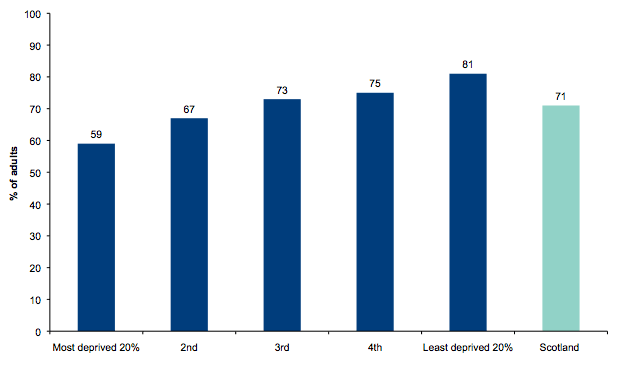
Participation by long-standing illness, health problem or disability
Figure 13.9 shows that those with a disability (62%), or illness or health problem (68%) are less likely to participate than those without (73%). It also shows that those who have both a disability and a long-term illness are the least likely to participate in any cultural activity (59%).
Figure 13.9: Participation in any cultural activity in the last 12 months by long-standing illness, health problem or disability
2009/2010 data, Adults (base: 18,757)
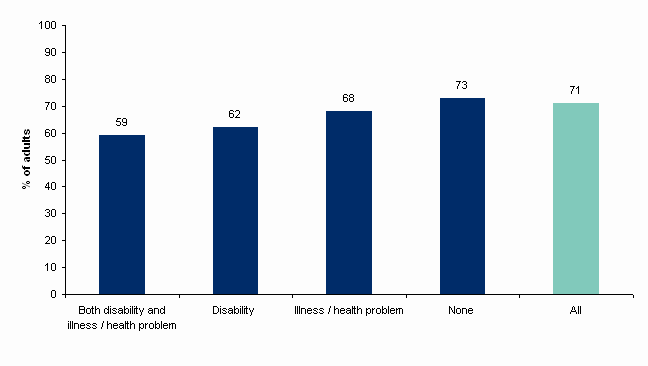
Participation in urban and rural areas
Figure 13.10 shows that around three quarters of adults in rural areas state that they participated in any cultural activity in the last 12 months (76% of respondents in remote rural areas and 73% in accessible rural areas). Cultural participation is lowest in other urban areas and accessible small towns (69% and 70% of adults respectively).
Figure 13.10: Participation in any cultural activity in the last 12 months by Urban Rural Classification
2009/2010 data, Adults (base: 18,746)
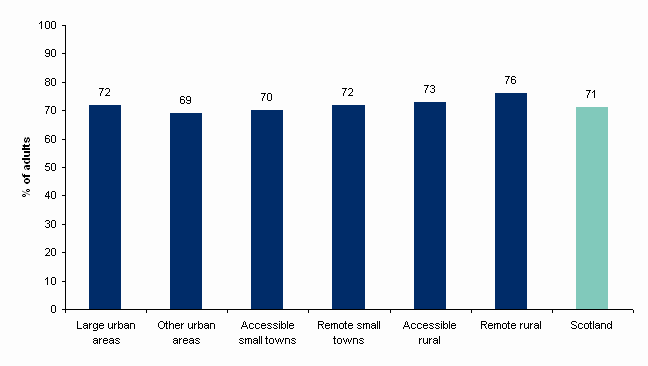
Table 13.9 shows that participation in specific cultural activities is generally highest in remote rural areas, but participation patterns are different in other areas in Scotland. For instance, dancing, reading for pleasure and painting are all comparatively popular in large urban areas and in more rural areas. In contrast, participation in crafts are more popular in more rural areas only. Levels of participation in other activities such as playing a musical instrument or writing music show no real difference between urban and rural areas.
Table 13.9: Participation in cultural activities in the last 12 months by Urban Rural Classification
Percentages, 2009/2010 data
| Adults | Large urban areas | Other urban areas | Accessible small towns | Remote small towns | Accessible rural | Remote rural | Scotland |
|---|---|---|---|---|---|---|---|
| Read for pleasure | 63 | 60 | 60 | 61 | 64 | 66 | 62 |
| Dance | 21 | 16 | 14 | 16 | 16 | 22 | 18 |
| Crafts such as textile, wood, pottery, etc. | 9 | 10 | 12 | 14 | 15 | 18 | 11 |
| Played musical instrument/written music | 11 | 10 | 11 | 10 | 11 | 12 | 11 |
| Painting/drawing/printmaking/sculpture | 10 | 8 | 8 | 7 | 9 | 12 | 9 |
| Photography | 8 | 6 | 7 | 8 | 8 | 10 | 7 |
| Computer artworks or animation | 7 | 6 | 5 | 7 | 7 | 7 | 7 |
| Rehearsed/performed/sang | 5 | 4 | 4 | 4 | 4 | 5 | 5 |
| Written stories/books/plays/poetry | 5 | 3 | 2 | 5 | 4 | 5 | 4 |
| Made films/videos | 2 | 2 | 1 | 2 | 1 | 2 | 2 |
| Other cultural activity | 1 | 1 | 1 | 1 | 1 | 1 | 1 |
| None | 28 | 31 | 30 | 28 | 27 | 24 | 29 |
| Base | 6,544 | 5,521 | 1,610 | 1,091 | 2,235 | 1,745 | 18,746 |
This question is only asked of three quarters of the sample.
Frequency of participating in cultural activities
Table 13.10 shows that reading for pleasure is the cultural activity which respondents most frequently participated in. Of those that read for pleasure in the last year, 83% state that they read at least once a week with a further 10% saying that they had read at least once a month. Playing a musical instrument or writing music is also a common activity, with over half (58%) of those who participated having done so at least once a week. The general pattern for many other cultural activities is that although a relatively small proportion of adults participated in them, those that did participate often did so frequently (at least once a month).
Table 13.10: Frequency of participating in cultural activities in the last 12 months
Row percentages, 2009/2010 data
| Adults | At least once a week | Less often than once a week but at least once a month | Less often than once a month but at least 3-4 times a year | Twice in the last 12 months | Once in the last 12 months | Don't know | Total | Base |
|---|---|---|---|---|---|---|---|---|
| Read for pleasure | 83 | 10 | 5 | 2 | 1 | 0 | 100 | 11,822 |
| Dance | 28 | 23 | 27 | 15 | 7 | 0 | 100 | 3,233 |
| Crafts such as textile, wood, pottery, etc. | 46 | 24 | 19 | 7 | 4 | 0 | 100 | 2,274 |
| Played a musical instrument or written music | 58 | 21 | 13 | 5 | 2 | 0 | 100 | 1,757 |
| Painting, drawing, printmaking or sculpture | 37 | 29 | 21 | 9 | 4 | 0 | 100 | 1,575 |
| Photography as an artistic activity (not family or holiday 'snaps') | 31 | 35 | 22 | 9 | 3 | 0 | 100 | 1,293 |
| Used a computer to create original artworks or animation | 34 | 26 | 21 | 10 | 8 | 1 | 100 | 1,053 |
| Rehearsed, performed or sang in front of audience, e.g. play or choir (not karaoke) | 34 | 21 | 20 | 10 | 14 | 1 | 100 | 751 |
| Written any stories, books, plays or poetry | 33 | 26 | 21 | 10 | 9 | 1 | 100 | 700 |
| Made films or videos as an artistic activity (not family or holidays) | 17 | 22 | 23 | 21 | 15 | 0 | 100 | 288 |
| Other cultural activity | 42 | 28 | 20 | 8 | 2 | 1 | 100 | 231 |
This question is asked of three quarters of the sample.
Other culture data available from the Scottish Household survey
The Scottish Household Survey Annual Report 2009/10 contains other relevant information on culture. These are outlined below. In addition, the "Scottish Household Survey People and Culture in Scotland, 2007/08" examines cultural attendance and participation in greater detail than in the SHS Annual Report.
Satisfaction with Local Authority Cultural Services
Since 2007, questions have been asked in the Local Services suite of questions in the Scottish Household Survey on the frequency of use and satisfaction with local authority cultural services. There is potential to obtain further information on people's perceptions of cultural services from these questions and this will become available with the publication of web tables from the Scottish Household Survey 2009/2010 Annual Report In particular, data are available on how frequently people use council run libraries, museums and galleries and theatres and concert halls. Data are also available on how satisfied they are with council run libraries, museums and galleries and theatres and concert halls.
Participation by young people in cultural activities
From 2009, questions have been asked in the Education and Young People suite of questions in the Scottish Household Survey on the extent to which young adults and children are regularly involved in a range of activities. These questions are asked of households for which there is someone aged between 8 and 21. In particular, data are available on participation in any music or drama activities such as playing in a band or a theatre group and participation in any other arts activities such as a photography or art club. Some analysis is presented in Chapter 7 of this report.
Scottish Household Survey: People and Culture in Scotland, 2007/08 report
This is a useful source of information on the barriers and levers to cultural attendance and participation. It may provide supplementary contextual evidence to support the results which have been obtained in this year's report.
In 2007 and 2008, a subsample of respondents from the Scottish Household Survey were asked a more detailed suite of questions about their cultural engagement. The "Scottish Household Survey: People and Culture in Scotland, 2007/08" [77] report contains results of a representative, random sample survey of around 6,800 adults (aged 16 years and over) in Scotland. The survey asked questions on the extent of people's cultural participation and attendance. It asked about reasons why people do or do not take part and reasons for visiting and attending places of culture. The questionnaire also explored exposure to cultural activities when growing up, use of the internet to access cultural websites, and volunteering (in general) and for culture and arts organisations. Findings from the "People and Culture in Scotland" report can be used to provide supplementary evidence to support some of the findings of the SHS 2009/2010 report.
Participation in Sport
The final questions in this section investigated levels of participation among adults in sport. A broad definition of sport is used and includes, for example, recreational walking for more than 30 minutes. For this question, adults were asked about participation in the last four weeks. The results are shown in Figure 13.11.
72% of people had participated in any sport in the last four weeks. By far the most prevalent activity was walking for 30 minutes (for recreational purposes). Over half (54%) had done this in the last four weeks compared with fewer than one-in-five undertaking any other individual activity. When walking was excluded, just over half of adults had undertaken at least one of the remaining sports activities in the last four weeks.
An error was identified in the 2009 SHS Annual Report. The percentage of adults who had undertaken sports grouped into the 'Other' category should have been 7% and not, as reported, 1%. The results from 2009/2010 that 7% of adult had undertaken sports categorised as 'Other' does not therefore represent a large change.
Figure 13.11: Participation in sport in the last four weeks
2009/2010 data, Adults (base: 18,756)
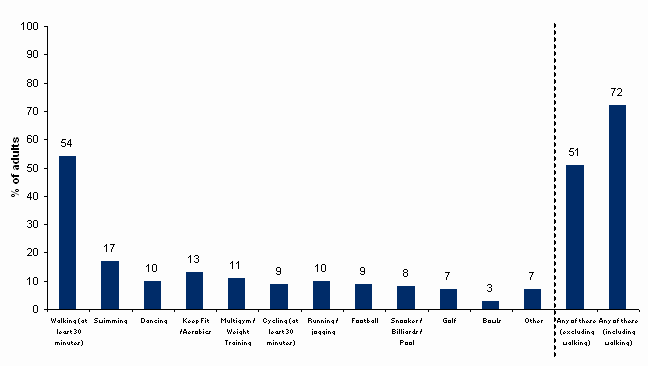
Previous analysis of SHS data [78] has shown that there is a relationship between participation in overall sport excluding and including walking and self-assessed health. Those who rated their own health over the last 12 months as good were more likely to participate in sport, though it is unclear from this to what extent good health is a result of taking part in sport or, instead, to what extent having good health enables participation in sport.
Table 13.11 shows that in 2009/2010, a higher proportion of people who rated their health in general to be 'very good' or 'good' participated in a sporting activity than those who had 'bad' or 'very bad' health. Including walking, 79% of those with 'good' or 'very good' health reported participating in any sporting activity over the past twelve months compared to 29% who said they had 'bad' or 'very bad' health.
Table 13.11: Participation in any sporting activity and self-assessed health over past twelve months
Column percentages, 2009/2010 data
| Adults | Very Good / Good health | Fair health | Very Bad / Bad health | All |
|---|---|---|---|---|
| Participation in any sporting activity excluding walking | ||||
| No | 42 | 65 | 83 | 49 |
| Yes | 58 | 35 | 17 | 51 |
| Total | 100 | 100 | 100 | 100 |
| Base | 13,207 | 4,110 | 1,425 | 18,742 |
| Participation in any sporting activity including walking | ||||
| No | 21 | 43 | 71 | 28 |
| Yes | 79 | 57 | 29 | 72 |
| Total | 100 | 100 | 100 | 100 |
| Base | 13,218 | 4,111 | 1,430 | 18,759 |
It can also be seen that there is an increasing trend of participation in sports as deprivation decreases (Table 13.12). Those living in the 20% least deprived areas of Scotland are much more likely to participate in any sporting activity (81%, including walking) compared to the 20% most deprived (60%).
Table 13.12: Participation in any sporting activity by Scottish Index of Multiple Deprivation
Column percentages, 2009/2010 data
| Adults | 20% most deprived | 2 | 3 | 4 | 20% least deprived | All |
|---|---|---|---|---|---|---|
| Participation in any sporting activity excluding walking | ||||||
| No | 58 | 53 | 50 | 44 | 39 | 49 |
| Yes | 42 | 47 | 50 | 56 | 61 | 51 |
| Total | 100 | 100 | 100 | 100 | 100 | 100 |
| Base | 3,592 | 3,832 | 3,997 | 3,996 | 3,312 | 18,729 |
| Participation in any sporting activity including walking | ||||||
| No | 40 | 32 | 27 | 24 | 19 | 28 |
| Yes | 60 | 68 | 73 | 76 | 81 | 72 |
| Total | 100 | 100 | 100 | 100 | 100 | 100 |
| Base | 3,598 | 3,836 | 4,003 | 3,997 | 3,312 | 18,746 |
Differences in sports participation levels between genders and between adults of different ages are explored in Table 13.13. The percentage of women who had participated in sport in the last four weeks was lower than the corresponding figure for men (69% versus 75%). Among different age groups, participation was highest among those aged 16 to 34 (84%), thereafter, participation decreased steadily until the age of 75, after which there was a sharp reduction with only 38% of those aged 75 and over engaging in sport in the past four weeks.
Table 13.13: Participation in sport in the last four weeks by gender and age
Percentages, 2009/2010 data
| Adults | Male | Female | 16 to 24 | 25 to 34 | 35 to 44 | 45 to 59 | 60 to 74 | 75 plus | All |
|---|---|---|---|---|---|---|---|---|---|
| Walking (at least 30 minutes for recreational purposes) | 53 | 55 | 52 | 61 | 60 | 57 | 52 | 29 | 54 |
| Swimming | 16 | 19 | 22 | 25 | 26 | 15 | 10 | 2 | 17 |
| Dancing | 7 | 13 | 17 | 13 | 9 | 9 | 8 | 3 | 10 |
| Keep Fit /Aerobics | 9 | 16 | 18 | 19 | 16 | 10 | 9 | 4 | 13 |
| Multigym use / Weight Training | 14 | 8 | 21 | 18 | 13 | 7 | 4 | 1 | 11 |
| Cycling (at least 30 minutes for recreational, health, training or competition purposes) | 12 | 6 | 10 | 11 | 15 | 9 | 5 | 1 | 9 |
| Running / jogging | 13 | 8 | 21 | 19 | 14 | 6 | 2 | 0 | 10 |
| Football | 17 | 1 | 26 | 15 | 8 | 4 | 1 | 0 | 9 |
| Snooker / Billiards / Pool | 14 | 2 | 21 | 11 | 8 | 4 | 2 | 1 | 8 |
| Golf | 12 | 2 | 7 | 7 | 9 | 7 | 8 | 3 | 7 |
| Bowls | 3 | 3 | 2 | 2 | 2 | 2 | 5 | 6 | 3 |
| Other | 9 | 6 | 10 | 10 | 9 | 7 | 4 | 2 | 7 |
| Any of these (excluding walking) | 57 | 46 | 71 | 67 | 61 | 46 | 36 | 17 | 51 |
| Any of these (including walking) | 75 | 69 | 84 | 84 | 79 | 71 | 63 | 38 | 72 |
| None of these | 25 | 31 | 16 | 16 | 21 | 29 | 37 | 62 | 28 |
| Base | 8,280 | 10,462 | 1,553 | 2,514 | 3,147 | 4,522 | 4,565 | 2,441 | 18,742 |
Columns add to more than 100% since multiple responses allowed.
This question is only asked of three quarters of the sample.
Walking was the predominant activity regardless of gender and for all age groups, though only 29% of those aged 75 and over participated in such walking activities. Similar proportions of men and women had walked for at least 30 minutes for recreational purposes in the past four weeks (53% and 55% respectively). The peak age group for walking was 25 to 34 (61%).
Over half of all adults had participated in sport (excluding walking) in 2009/2010. Participation was higher among men (57%) than women (46%) and declined with age (for example 71% of those aged 16 to 24 compared with 17% of those 75 or over had participated in other sports activities).
There were some differences between the other sports and physical activities. The activities with the highest participation in the last four weeks after walking were swimming (17%), taking part in keep fit or aerobics (13%) or multigym use/weight training (11%); a higher proportion of women than men had undertaken both swimming and taking part in keep fit or aerobics. Participation in all other individual physical activities (other than dancing) was higher or equal among men than women.
For the majority of activities (excluding walking), participation in the last four weeks broadly decreased with age. Exceptions to this included: cycling where the peak age was 35-44 (15%); swimming which showed increasing participation between the ages of 16 and 44, decreasing thereafter; and, golf where a similar proportion of all ages up to 75 had played golf in the past four weeks. Those aged 60 and over were more likely to have played bowls in the last four weeks than any other age group (5% of those aged 60-74 and 6% of those aged 75 and over), although participation in bowls was relatively low among all adults (3%).
Table 13.14 shows that in nearly all sporting activities, as area deprivation decreased participation increased. The exceptions to this were; dance, football and bowls which saw similar participation levels across all areas. Snooker, billiards or pool show higher participation rates in the more deprived areas ( e.g. 9% in the 20% most deprived areas) as compared to 7% in the 20% least deprived areas. The table also shows those who rated their health as good in the last 12 months were more likely to participate in all sports.
Table 13.14: Participation in sport in the last four weeks by Scottish Index of Multiple Deprivation and self-assessment of health in past 12 months
Percentages, 2009/2010 data
| Adults | 20% most deprived | 2 | 3 | 4 | 20% least deprived | Very Good/Good health | Fair health | Very Bad/Bad health | All |
|---|---|---|---|---|---|---|---|---|---|
| Walking (at least 30 minutes for recreational purposes) | 42 | 49 | 56 | 60 | 63 | 60 | 43 | 20 | 54 |
| Swimming | 14 | 16 | 17 | 20 | 21 | 21 | 10 | 5 | 17 |
| Dancing | 9 | 11 | 9 | 11 | 10 | 12 | 7 | 3 | 10 |
| Keep Fit/Aerobics | 11 | 12 | 12 | 13 | 16 | 15 | 8 | 4 | 13 |
| Multigym use/Weight Training | 7 | 9 | 10 | 12 | 14 | 13 | 5 | 2 | 11 |
| Cycling (at least 30 minutes for recreational, health, training or competition purposes) | 5 | 6 | 10 | 12 | 13 | 11 | 5 | 1 | 9 |
| Running/jogging | 7 | 9 | 9 | 11 | 14 | 13 | 4 | 1 | 10 |
| Football | 9 | 9 | 8 | 9 | 9 | 10 | 5 | 1 | 9 |
| Snooker/Billiards/Pool | 9 | 9 | 7 | 7 | 7 | 8 | 6 | 3 | 8 |
| Golf | 3 | 5 | 7 | 9 | 11 | 9 | 4 | 1 | 7 |
| Bowls | 3 | 3 | 3 | 3 | 3 | 3 | 2 | 1 | 3 |
| Other | 3 | 5 | 8 | 9 | 11 | 9 | 4 | 2 | 7 |
| Any of these (excluding walking) | 42 | 47 | 50 | 56 | 61 | 58 | 35 | 17 | 51 |
| Any of these (including walking) | 60 | 68 | 73 | 76 | 81 | 79 | 57 | 28 | 72 |
| None of these | 40 | 32 | 27 | 24 | 19 | 21 | 43 | 72 | 28 |
| Base | 3,592 | 3,832 | 3,997 | 3,996 | 3,312 | 13,202 | 4,102 | 1,425 | 18,729 |
Columns add to more than 100% since multiple responses allowed.
This question is only asked of three quarters of the sample.
Frequency of participation in sports
Having established the percentage of adults taking part in sport in the last four weeks, those who participated in the activities were asked the number of days they had undertaken at least one of them during that period (rather than using a frequency scale). This enabled an average to be calculated from the answers provided, which is shown in the last row of Table 13.15. On average adults had undertaken sporting activity on over 13 days in the last four weeks, which would equate to a frequency of around three days per week.
Table 13.15: Frequency of participating in sport in the last four weeks by gender and age
Column percentages, 2009/2010 data
| Adults | Male | Female | 16 to 24 | 25 to 34 | 35 to 44 | 45 to 59 | 60 to 74 | 75 plus | All |
|---|---|---|---|---|---|---|---|---|---|
| 1-4 days | 25 | 26 | 25 | 26 | 24 | 27 | 24 | 26 | 25 |
| 5-8 days | 18 | 19 | 19 | 20 | 19 | 17 | 17 | 19 | 18 |
| 9-14 days | 15 | 16 | 14 | 17 | 18 | 15 | 15 | 14 | 16 |
| 15-20 days | 15 | 13 | 16 | 15 | 14 | 13 | 13 | 13 | 14 |
| 21-28 days | 25 | 26 | 25 | 22 | 25 | 27 | 30 | 26 | 26 |
| Total | 100 | 100 | 100 | 100 | 100 | 100 | 100 | 100 | 100 |
| 'Mean' | 13.5 | 13.6 | 13.4 | 12.8 | 13.5 | 13.5 | 14.3 | 13.6 | 13.5 |
| Base | 5,923 | 6,853 | 1,285 | 2,093 | 2,480 | 3,176 | 2,847 | 895 | 12,776 |
This question is only asked of three quarters of the sample.
The frequency of taking part in these activities in the last four weeks does not vary by gender nor, broadly, by age. However, perhaps surprisingly, of those participating in sporting activities, the average number of days in which people participated in sport increased over the age of 60. Those aged 60 to 74 undertook an average of 14.3 days of participation in sporting activities in the previous four week period which equates to close to four days a week. Almost a third of adults in this age group (30%) participated in sport at least 5 days a week (21 to 28 days over a four week period).
The slightly higher participation rate among 60 to 74 year olds may be affected by a number of factors. Those from the older age group are likely to be retired and hence have more opportunities to participate in sporting activities. Also, these figures do not record the intensity or duration of participation so although those aged 60 and over do sport most often it may be at a lower intensity or for shorter periods than those in younger age groups.
There is a problem
Thanks for your feedback